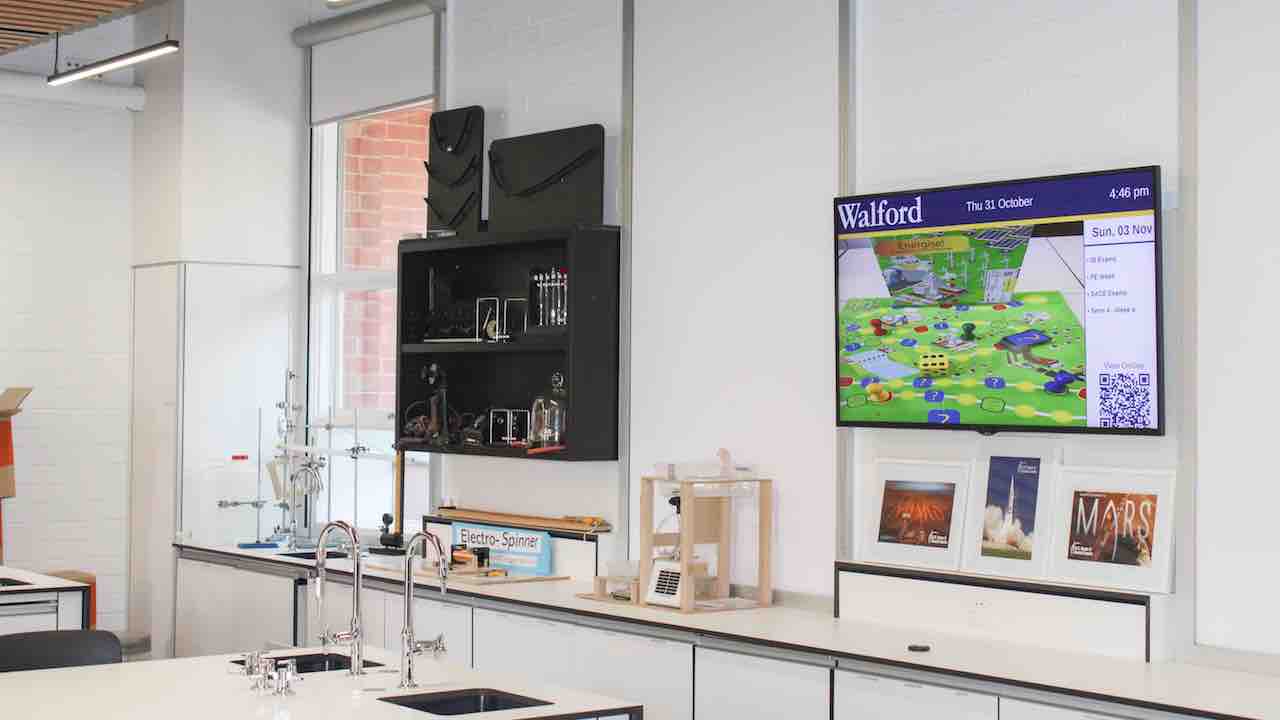Digital signage has long been used as an efficient means of delivering branding messages and pertinent information. As the category has evolved, technology developers have continued to build increasingly sophisticated solutions that incorporate data analytics to help organizations tailor their messaging and provide a better experience for customers, guests, and employees. Over the last couple of months, the terms “experience” and “engagement” have taken on new meanings as organizations worldwide navigate operations during a pandemic—and the digital signage category is playing a significant role in this.
Pandemic or not, one of the first steps in optimizing digital signage is location, location, location. At Carousel Digital Signage, a software platform developer headquartered in Minneapolis, MN, the secret to boosting engagement and improving experience is by communicating to people where they actually are. JJ Parker, CEO, explained that his company is focused on providing solutions for the corporate and education markets; the “audiences” the technology is addressing, then, is primarily made up of employees and students. Through the application of its platform alongside Apple TV, Zoom, and Mersive collaboration technology, Carousel urges its users to move digital signage from common areas to classrooms and collaboration spaces, where people have the time to digest what’s on display.
Related: The Integration Guide to Video Walls 2020

“If you think of a school, the students are hustling [from] classroom to classroom and not really hanging out in the hallways where, typically, the digital signage was. Putting the signage and those announcements in those classrooms is a way of communicating to them where they have some idle time to consume that information,” Parker illustrated. The same can be said for collaboration spaces: “How many times have you been sitting in a conference room waiting for a meeting to start? What a perfect spot to share our core values, our recent wins, our sales metrics, and quotes from our loving customers?”
John Melillo, senior vice president of the Digital Media Group at Kenilworth, NJ-based Diversified, believes that when done right, digital signage has the potential to significantly shape an organization’s branding effort. “That [digital signage] network is going to create an overriding image, right from the open lobby where it’s creating that first impression of what that organization is—not just for visitors, but [also] for the employee base,” he said. On a basic level, these systems may communicate a company’s story: “who we are, what we stand for.” But they may also be leveraged to demonstrate how well (or how poorly) the organization takes care of its employees and visitors through, say, optimized wayfinding and interactive functionality. “[Technologists] are intrinsic to the brand of their organization,” he said. “They are contributing in a very physical, visceral way.”
With the COVID-19 crisis changing the conversation around engagement, digital signage companies are stepping to the forefront with offerings that respond to new public health concerns alongside their traditional product lineups. Navori Labs, a digital signage software developer headquartered in Lausanne, Switzerland, is rolling out QL Access Control, a module for the its QL Digital Signage Software platform. Designed to help facilities regulate foot traffic, the system—which leverages Navori’s Computer Vision AI technology—performs functions such as density monitoring and face mask detection. Jeffrey Weitzman, managing director at the company’s North American headquarters in Montreal, Quebec, noted that this solution has the potential to eliminate the need for guards at facility entrances to monitor traffic and verify whether visitors are, indeed, wearing protective masks. He also pointed out that it can serve as reassurance: “There is a need to instill confidence in consumers that we, as a retailer [for example], have taken it upon ourselves to keep you safe,” he said.

One issue with interactive digital signage these days is that people are fearful of touching pretty much anything outside of their homes. Ann Holland, vice president of marketing at BrightSign noted that the pandemic has driven her company to introduce BrightLink, a solution that doesn’t require users to touch a screen directly. “It’s a feature whereby a viewer of digital signage is instructed to scan the QR code on screen, and this establishes a two-way connection between the viewer’s phone and the screen,” she said. The viewer can then control the screen from their phone without having to download an app or even access an internet connection; instead, a BrightSign player with a wireless module serves as an access point. “This same feature can be enabled in restaurants so that patrons can view the menu on their personal devices, eliminating the need to provide diners with a physical menu that may or may not be clean.”
In addition to BrightLink, BrightSign offers BrightVoice, which, as Holland explained, utilizes a “wake word” to prompt the signage to go into listen mode, enabling the viewer to then engage with it. The company has also partnered with BlueFox.io on a solution called BlueFox Count, which performs density monitoring based on the number of mobile devices that are located within a distance of up to 100 feet from the sensor. Alerts are then sent via text message to facility managers or a venue supervisor, and digital signage at a building’s entrance can display head count data, letting security personnel know whether or not more people may be admitted to the complex, or if they have to wait to get inside.
Diversified’s FocalPoint is a digital signage-as-a-service offering originally developed to streamline the deployment, replacement, or upgrade process for facilities. In response to COVID-19, the company has been adding public health-related extensions to the platform, such as VitalSign, which monitors a person’s temperature from three feet away, within one second. The system is available as a freestanding or wall-mounted kiosk. “Our clients are seeking this as states start to loosen their rules,” Melillo said. “We want to be prepared for that, and then work beyond that.”

Back in April, Carousel began offering free, short-term packages to frontline organizations (such as pop-up hospitals and healthcare facilities, and essential businesses) to streamline up-to-the minute communications in facilities dealing with the crisis first hand. The package comprised a three-month subscription of Carousel Cloud (the company’s cloud-based CMS), “Frontline Responder” templates for user-friendly creation and delivery of emergency messaging, as well as training and support. Those interested were encouraged to leverage existing technology on hand (such as traditional TVs and Apple TV devices) as displays, which the Carousel solution configures as media players when connected.
Parker believes that in the context of a crisis like this, digital signage provides an intuitive method for constant communication—a crucial component of crisis management. “In these facilities, we can use digital signage to communicate really quickly with everybody,” he said. “Changing those messages on a daily or maybe even hourly basis becomes important. And we can see how efficient communication can have a really positive effect on our spaces, on our community, and on our globe as a whole.”
Communication has always been important, but Weitzman believes that organizations will be placing an increasing emphasis on giving customers, visitors, and employees the information they require to adhere to public health standards, as well as in-house security rules. “I think one trend in all settings will be more digital signage because safety information is critical,” he said. “Digital signage is going to become one of the primary communications vehicles.” That said, in order for it to be effective, it will have to integrate well with things like camera systems and analytics. “The future of digital signage is heavily weighted on its ability to be smart so that content is up to date and immediately relevant.”

Digital signage can get complex, but it doesn’t have to be, argues JJ Parker, CEO at Carousel Digital Signage. He urges tech managers to seek out technologies that enable zero-touch deployment—what he affectionately refers to as “shrink wrap to signage.”
“[A zero-touch deployment] means you can get a media player device and unbox it, plug it into the network and power, and it becomes a signage player without you having to do anything to it—you don’t have to load an app onto it, you don’t have to configure its network,” Parker said. “Make sure, when deploying 10, 100, or thousands of media players, that it’s easy and you don’t have to go and touch every single one. The hidden cost of signage is the deployment and maintenance. As a tech manager, you’ve got to think about the maintenance cost.”
Carolyn Heinze is a freelance writer/editor.
